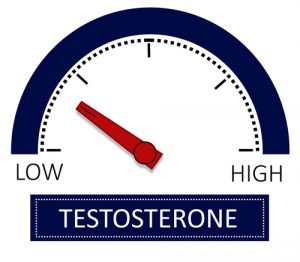Many factors contribute to American men’s failings to recognize the role of low testosterone, or low T, in aging symptoms.
The Meaning of Testosterone
As men age, there is a gradual, but significant, reduction in the blood levels of testosterone, the primary sex hormone in men. This hormone rises rapidly during puberty and develops, regulates and maintains the male sex characteristics:
- Deep voice and widening of shoulders
- Muscle and bone mass
- Face and body hair
- Sperm production
- Increased libido
- Growth of the penis and testicles
The hormone also influences male fat distribution. Some people may not know that it also has the non-sexual function of helping produce red blood cells, which carry oxygen throughout the body. A lack or dysfunction of these cells can cause anemia, which may result in feelings of weakness and fatigue. Men generally have higher red blood cell counts than women do. Women also produce testosterone but in much smaller amounts, about one-tenth of men’s.
Low Testosterone Symptoms

Since testosterone is an anabolic hormone, meaning it builds muscle tissue, one of the main symptoms of a deficiency is a loss of muscle mass and power. Other symptoms may include the following:
- Loss of libido
- Depression
- Mental confusion
- Erectile dysfunction
- Fatigue
- Osteoporosis or loss of bone strength
- Mood changes
- Weight gain and redistribution of body fat
- Irritability
- Lethargy and loss of motivation and drive
When you look at this list, you will see how easy it really is to mistake low T for something else. Except for possibly erectile dysfunction, none of these symptoms would be likely to be readily recognized as a hormonal problem. Even erectile dysfunction might be mistaken for a side effect of another disease, such as diabetes or heart disease or even as a result of an emotional issue.
Diagnosis of Low T
The symptoms of low testosterone typically first appear in the mid-forties or so and then intensify as a man ages and hormone levels further decline.
The medical term for low T is andropause. It’s a normal part of the male aging process. However, if symptoms of a potential low T problem bother you, your physician can evaluate and diagnose the condition with a physical exam, a list of your symptoms and a simple blood test.
There are two types of circulating testosterone in the blood: free testosterone and bound testosterone. It’s the free testosterone that is available for your body to easily use, and this is the figure your doctor will be looking at the most. A normal hormone level of total testosterone is between 270 and 1070 nanograms per deciliter of blood, but only a small percentage of this total will be in the form of free testosterone.
If your doctor determines that your symptoms could be caused by low T, he or she may prescribe testosterone supplements to raise your free hormone levels. These are available as skin patches, topical gels and creams, tablets and capsules, injections and implantable pellets inserted under the skin.
Conclusion
Having previously failed to recognize low testosterone’s role in aging symptoms doesn’t mean that men have to tolerate disturbing symptoms. Education is the key. Talk to your doctor and find the most appropriate course of action for you.





